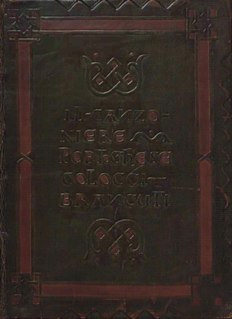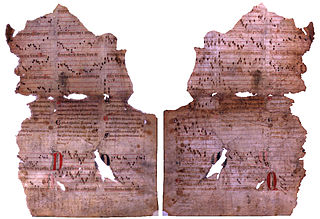
The Cantigas de Santa Maria are 420 poems with musical notation, written in the medieval Galician-Portuguese language during the reign of Alfonso X of Castile El Sabio (1221–1284) and often attributed to him.

Medieval music consists of songs, instrumental pieces, and liturgical music from about 500 A.D. to 1400. Medieval music was an era of Western music, including liturgical music used for the church, and secular music, non-religious music. Medieval music includes solely vocal music, such as Gregorian chant and choral music, solely instrumental music, and music that uses both voices and instruments. Gregorian chant was sung by monks during Catholic Mass. The Mass is a reenactment of Christ's Last Supper, intended to provide a spiritual connection between man and God. Part of this connection was established through music. This era begins with the fall of the Western Roman Empire in the fifth century and ends sometime in the early fifteenth century. Establishing the end of the medieval era and the beginning of the Renaissance music era is difficult, since the trends started at different times in different regions. The date range in this article is the one usually adopted by musicologists.

The Trecento refers to the 14th century in Italian cultural history.

Martin Codax or Martim Codax was a Galician medieval joglar - possibly from Vigo, Galicia in present-day Spain. He may have been active during the middle of the thirteenth century, judging from scriptological analysis. He is one of only two out of a total of 88 authors of cantigas d'amigo who used only the archaic strophic form aaB. He employed an archaic rhyme-system whereby i~o / a~o were used in alternating strophes. In addition Martin Codax consistently utilised a strict parallelistic technique known as leixa-pren. There is no documentary biographical information concerning the poet, dating the work at present remains based on theoretical analysis of the text.

Mendinho, also Meendinho, Mendiño and Meendiño, was a medieval Iberian poet.
Johan de Cangas was a jograr or non-noble troubadour, probably active during the thirteenth century. He seems to have been from—or associated with – Cangas do Morrazo, a small town on Pontevedra, Galicia (Spain). Only three of his songs survive. All three are cantigas de amigo and in each of them the girl mentions a religious site (ermida) at San Momede do Mar. These references to the sea may be symbolic as they are real, but they have has earned this poet the designation of "singer of the sea". In the first text, a girl asks her mother for permission to go see her boyfriend at San Momede do Mar; in the second she informs her mother than the boyfriend did not come and she has surely lost him; in the third she asks her boyfriend to meet her there, and not to break his word to her again.
The Cantiga de amigo or Cantiga d'amigo, literally a "song of a friend", is a genre of medieval lyric poetry, apparently rooted in a song tradition native to the northwest quadrant of the Iberian Peninsula. What mainly distinguishes the cantiga de amigo is its focus on a world of female-voiced communication. The earliest examples that survive are dated from roughly the 1220s, and nearly all 500 were composed before 1300. Cantigas d'amigo are found mainly in the Cancioneiro Colocci-Brancuti, now in Lisbon's Biblioteca Nacional, and in the Cancioneiro da Vaticana, both copied in Italy at the beginning of the 16th century at the behest of the Italian humanist Angelo Colocci. The seven songs of Martin Codax are also contained, along with music, in the Pergaminho Vindel, probably a mid-13th-century manuscript and unique in all Romance philology.
A cantiga is a medieval monophonic song, characteristic of the Galician-Portuguese lyric. Over 400 extant cantigas come from the Cantigas de Santa Maria, narrative songs about miracles or hymns in praise of the Holy Virgin. There are near 1700 secular cantigas but music has only survived for a very few: six cantigas de amigo by Martín Codax and seven cantigas de amor by Denis of Portugal.

The Cancioneiro da Biblioteca Nacional, commonly called Colocci-Brancuti, is a compilation of Galician-Portuguese lyrics by both troubadours and jograes. These cantigas (songs) are classified, following indications in the poems themselves and in the manuscript tradition, into three main genres: cantigas de amigo, cantigas de amor and cantigas de escárnio e mal-dizer.

The Pergaminho Sharrer is the name given to a mediaeval parchment fragment containing seven songs by King Dinis I of Portugal, with lyrics in the Galician-Portuguese language and musical notation.
Rodrigo de Ceballos was a Spanish composer.

In the Middle Ages, the Galician-Portuguese lyric, also known as trovadorismo in Portugal and trobadorismo in Galicia, was a lyric poetic school or movement. All told, there are around 1680 texts in the so-called secular lyric or lírica profana. At the time Galician-Portuguese was the language used in nearly all of Iberia for lyric poetry. From this language derives both modern Galician and Portuguese. The school, which was influenced to some extent by the Occitan troubadours, is first documented at the end of the twelfth century and lasted until the middle of the fourteenth, with its zenith coming in the middle of the thirteenth century, centered on the person of Alfonso X, The Wise King. It is the earliest known poetic movement in Galicia or Portugal and represents not only the beginnings of but one of the high points of poetic history in both countries and in Medieval Europe. Modern Galicia has seen a revival movement called Neotrobadorismo.
Renaissance Ensemble Serbia is the first early music ensemble in Serbia and the second in south-eastern Europe, having been founded in 1968. Ensemble Renaissance usually focuses on the music of the Middle ages, Renaissance and Baroque. Occasionally, however, Ensemble performs modern music on ancient instruments.
A cantilena is a vocal melody or instrumental passage in a smooth, lyrical style.
Eduardo Paniagua is a Spanish architect and musician, specializing in medieval Spanish music.
Cappella Neapolitana is an early music ensemble based in Naples and dedicated to the recovery of Neapolitan musical heritage, primarily from the baroque era.
Alba are a Danish medieval music ensemble founded in 1992. The ensemble consists of the duo Agnethe Christensen and Poul Høxbro, or the trio with the harpist Helen Davis.
Cappella Artemisia is an Italian all-female vocal group specializing in the music of the convents of 17th Century Italy. The group was founded by the American, but resident in Italy, singer and musicologist Candace Smith. Smith is also co-publisher, with her husband cornettist Bruce Dickey of editions of this music through Artemisia Editions. The main repertoire of the group focuses on nun composers themselves - including Raphaella Aleotti, the first nun to publish as a composer, Maria Xaveria Perucona and Isabella Leonarda, Chiara Margarita Cozzolani and Rosa Giacinta Badalla, Sulpitia Cesis, Alba Tressina, Lucrezia Orsina Vizzana and Caterina Assandra. The ensemble also performs works of the male composers - some monks, some secular, who dedicated works to the covents.
Enrico Baiano is an Italian harpsichordist and fortepianist, known on the international stage as a virtuoso and strict interpreter of early music.








